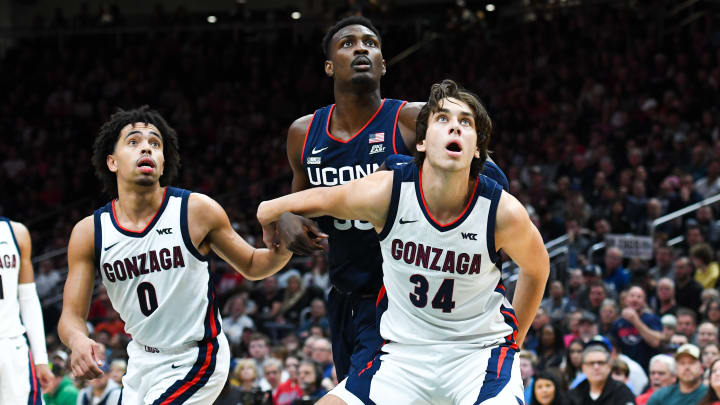What UConn-Big 12 talks means for Gonzaga’s future in WCC

Sometime this week, Big 12 commissioner Brett Yormark will share with league members an expansion plan that’s centered around adding UConn in all sports, except football, by 2026.
As reported last week, UConn school officials met with Big 12 leaders in Dallas, Texas, and made an in-person pitch that detailed a heavy investment plan into the school’s struggling football program, which is one of the last two FBS independent teams in the country. The plan would include UConn football staying independent before joining the Big 12 in 2031 and not require current members to take a revenue cut as such. Despite UConn’s dominant men's and women's basketball programs, some Big 12 members are still apprehensive about another wave of expansion in part because of the school’s lack of success and revenue generated on the gridiron over the past decade.
Football is and will likely continue to be a driver in all things related to conference realignment, but there’s still a lot for the Big 12 to sort out if 12 of its current 16 members vote in favor of adding the league’s ninth school within the past two years. Conference presidents and athletic administrators haven’t even seen the newest members — Arizona State, Arizona, Colorado and Utah — take a single snap of the 2024-25 college football season and won’t know the ramifications of last summer’s additions (Houston, Cincinnati, Central Florida, BYU) until at least a few more years. At the same time, college athletics is wrapping its head around the House v. NCAA settlement and how revenue-sharing with student-athletes will work, as schools and conferences are having to find creative ways to bring in money in order to keep up with the power conference programs.
Yormark has been aggressively setting up the Big 12 for the future through explorations into conference expansion, league naming rights and private equity investments. He seeks to create the best college basketball conference possible as well, which is why he’s heavily courted Gonzaga over the past few years. The Bulldogs’ lack of football didn’t appeal to some of the Big 12’s members, which is consistent in some of the pushback regarding UConn’s inclusion.
If Yormark’s persistence prevails this time, however, and a majority of the league votes in favor of adding the Huskies to all Olympic sports by 2026, it could be the next ripple effect that starts the next wave of conference expansion.
UConn’s departure from the Big East would be a massive blow for the non-FBS conference. The Huskies have won the last two national championships in dominant fashion and have one of the best coaches in the sport in Dan Hurley. Since he took over the program in 2019, UConn is 141-58 overall and an impressive 14-4 in the NCAA Tournament.
Granted, the Big East proved it didn’t need UConn to still be considered a top-five conference in the country when the school was a member of the American Athletic Conference from 2014-2020. But the Huskies’ name-brand value is harder to make up for in the aggregate, no doubt, which could prompt conference commissioner Val Ackerman to add another high-profile basketball program to be the next face of the league.
Mark Few and the Zags make an interesting case for the Big East given their success in the NCAA Tournament over the past quarter-century as members of the WCC. Gonzaga has been to nine straight Sweet 16s and has never missed the Big Dance in the Few-era (since 1999) while also claiming at least a share of the league’s regular season title in 11 of the past 12 seasons.
The school’s commitment to the hardwood matches the energy of the Big East, which has had at least two teams advance to the Sweet 16 or further for four straight postseasons. Ackerman even said herself that there's "no better fit for Gonzaga than the Big East” during the conference’s media day this past October. Hurley as well said “Maybe Gonzaga will want to join a really good basketball league” after the Huskies’ win over the Bulldogs at Climate Pledge Arena in December.
Since then, however, the WCC made some moves of its own to strengthen its basketball roster. In the span of five months, league commissioner Stu Jackson threw out a life preserver for Washington State and Oregon State to hang on to for at least two seasons, then added another NCAA Tournament team in Grand Canyon and a big media market in Seattle University for 2025-26 and beyond. Time will tell how the additions pan out over the next few years, though it’s still worth noting that Gonzaga was apparently “extremely supportive” of the WCC’s plan to expand.
“I will say on Gonzaga's behalf they have always behaved throughout the [conference realignment] rumors, and the speculation about their departure, they have always behaved as a true and invested partner in the WCC,” Jackson said during a press conference in May. “And also throughout this process, as we've added members, they have been extremely supportive.”
When also taking into account the unusual geographical fit — the closest Big East school to Spokane is Creighton in Omaha, Nebraska, located over 1,300 miles away, with Providence being the farthest at over 2,700 miles away — it doesn’t seem likely the Bulldogs are going anywhere any time soon.
How Big 12 leaders receive Yormark’s presentation, with regard to UConn’s football program especially, could indicate how ambitious they would be about adding Gonzaga as well.
